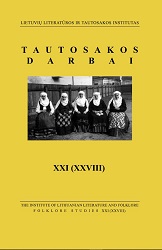Tautosakinis gegutės įvaizdis
The Image of Cuckoo in Folklore
Author(s): Lilija KudirkienėSubject(s): Customs / Folklore
Published by: Lietuvių literatūros ir tautosakos institutas
Keywords: interpretation of the cuckoo’s image in folklore in terms of values or aesthetics; or in semantical functional aspect;
Summary/Abstract: Unlike some other images, such as those of the Sun, an orphan, etc., there is no unanimous interpretation of the cuckoo’s image in folklore; no clear dominant can be discerned: neither in terms of values or aesthetics, nor in semantical functional aspect. The diversity and inconsistency of the cuckoo’s image could be explained by motivation stemming from different sources: in some cases it is based on mythical beliefs, whereas in others – on the natural peculiarities of a real cuckoo. Almost all the European peoples see cuckoo as a fortune-teller: by its call the cuckoo predicts the coming year to be good or bad, warns of a famine or war, disease or death (more frequently it predicts bad things than good ones). According to the cuckoo’s call and its various circumstances (Kuckuck ueber dem Stock… Kuckuck ueberm Huegel… ‘Cuckoo [calling] on a stake… Cuckoo [calling] on a hill’) the length of a human life or its different stages (e.g. girlhood, shepherding) is conjectured. The negative consequences of hearing a cuckoo’s call on an empty stomach or while strapped for cash were shunned of. This is also where the figurative images of “cuckoo’s bite” and “cuckoo’s money” come from. The call of the cuckoo sounds sad, yet pleasant to the ears of Lithuanians, Latvians and Slavs. Meanwhile Germans regard it as ugly and boring, and therefore the bird itself is deemed as common, slow and is often sneered at. The Balts and Slavs, however, regard cuckoo as a symbol of a grieving person, more frequently a female (a widow, a mother, a daughter-in-law, an orphaned girl, etc.). True, Latvians have an unfavorable image of a “famine cuckoo”, more or less familiar to Lithuanians as well (derived upon generalization of a complaining function, attributed to the cuckoo in folklore), whereas Lithuanians and Slavs have a similarly uncomplimentary image of a “nocturnal cuckoo” (based upon an aspect of femininity associated with cuckoos). Moreover, Germans and some Slavic peoples regard cuckoo as a liar and fraud, breaker of its promises (this interpretation originates from imagining cuckoo as a fortune-teller). Germans reproach cuckoo with ingratitude (this being related to the natural peculiarities of a real cuckoo). The fact that cuckoos in nature laid their eggs in the nests of other birds, not hatching and nurturing the little ones by themselves, motivated association of this bird with adultery in German folklore tradition, or portraying it as a frivolous female and an irresponsible mother by Lithuanians and some Slavs.
Journal: Tautosakos darbai
- Issue Year: 2004
- Issue No: 28
- Page Range: 55-69
- Page Count: 15
- Language: Lithuanian

